Join our Larry McDonald on CNBC’s Trading Nation, Wednesday at 3:05pm ET
Pick up our latest report here:
Don’t miss our next trade idea. Get on the Bear Traps Report Today, click here“We believe inflation is set to finally pick up in 2018. Much of the passive and quant-side (a $1.5T shift in asset management) has become heavily invested in the “risk parity” model which involves being long equities and bonds on a risk-adjusted basis. One of the fundamental problems with this strategy is you’re effectively really long disinflation. Sure, it’s worked very well in the post great financial crisis period, but it’s a grossly crowded trade and has all the makings of a gruesome slaughterhouse. In this case, the risk tail is a period where equities and bonds fall together, which is not that uncommon in a late cycle inflationary environment (see 1980s and 1990s). Other than out of the money puts in rates (bonds) a big way for this crowd to hedge inflation is to increase commodity exposure. As long-time bulls, we’re now ‘pounding the table’ bond bears for 2018.”
Bear Traps Report, January 2, 2018
Inflow of into Passive MF and ETFs
January
2018: $105B
2017: $68B
2016: $18B
2015: $22B
Bloomberg data
Many of these investors don’t realize, passive investing in bond ETFs is a colossal disinflation bet. As the tide turns, this mad mob will rush for the exits, commodities will become the big winners relative to bonds and equities.
Hot Wages
U.S. payrolls surged by 200k in January, ahead of Street expectations for 190k. Gains were largely in the private-sector hiring (+196k). The unemployment rate remained unchanged at 4.1%.
Wage growth caught all the attention in this report, and it didn’t disappoint. Average hourly earnings rose a relatively strong 0.3% in January and accelerated to 2.9% year-over-year. That marks the fastest pace of wage gains since 2009.
ISM Prices Paid are on Fire
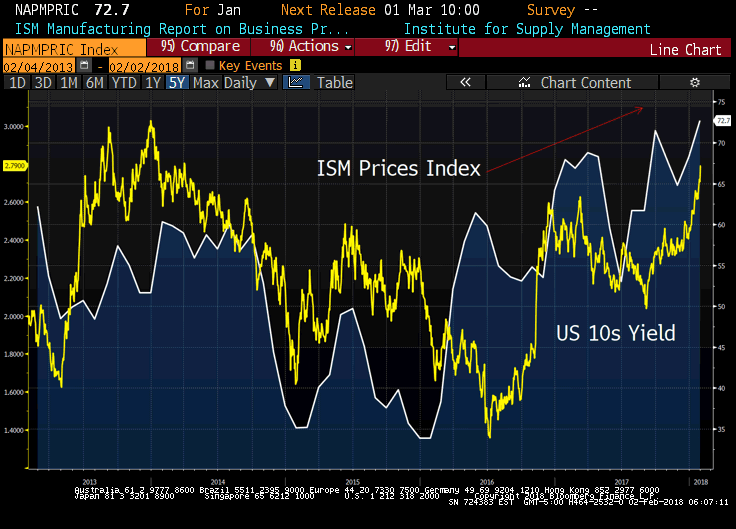
This week we saw hot ISM prices paid (U.S. factories expanded more than forecast in January and near the fastest pace in more than 13 years). While ISM’s measure of prices paid increased to the highest level since May 2011 (keep in mind, U.S. 10 year bond yields were up near 3.50% in the Spring of 2011). What’s driving all the bearish bond sentiment? One major reason is found in the “growth to bold yield” disconnect. For most of the last fifteen years, the U.S. 10 year bond yield was “tied to the hip” of manufacturing ISM prices paid. In our view – as you can see above – the current level of ISM prices paid should be associated with U.S. Treasury bond yields 60-70bps (+0.60% to +0.70%) higher than current levels. In recent years as inflation expectations plunged, the disconnect between ISM and 10s (Treasury bonds) widened. Over the last month, as inflation expectations surged, these two long lost friends are spending far more time together.
US Equity Long Futures Positioning
2018: $405B
2017: $280B
2016: $185B
2015: $280B
2014: $240B
2013: $220B
2012: $155B
2011: $160B
2010: $150B
2009: $130B
2008: $280B
2007: $210B
2006: $180B
CFTC, GS data
Heading into February, investors have never been this long equities. We use CFTC (positioning, measuring the crowded trade) data as an important contrarian indicator. Over the years, as positioning wanes (2006, 2009, 2016), these are the best times to over-weight stocks. In the bond market, the sensitivity to a rate change (in prices and wages) is greater than ever before. It is very high, in our view the U.S. is hitting capacity constraints and risks overheating. The Trump tax cuts and spending plans are further juicing the economy at the wrong moment. At the same time, a weaker dollar adds even more stimulus (with over $60T of GDP outside the U.S. vs. $18T inside, a weak dollar injects emerging market economies with a steroid like high). In Davos, Axel Weber (former Bundesbank head) said: “today we’re adding stimulus on stimulus, this is after the credit channel mechanism of monetary policy shut down when interest rates collapsed to zero during the post-Lehman slump.” Quantitative easing lifted the economy through a different mechanism, by boosting financial markets – a wealth effect from gains in equities, bonds, and property. “People have been lulled into complacency, forgetting what will happen when normal conditions return,” Weber said. We’re now switching back on the credit and interest rate channel. We do NOT believe central bankers can effectively manage the risk path they are on.
Bond Yields and Equity Market Volatility, now in a Regime Change
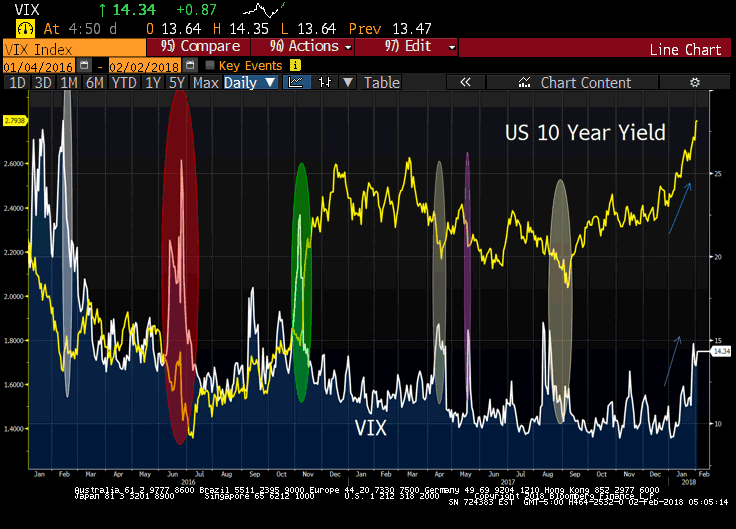
This week, with nearly a 4% drawdown, the S&P 500 just posted its biggest (weekly) loss in two years. If you look carefully above, we’re clearly in the middle of an important regime change. In recent years as volatility surged, long bonds (U.S. Treasuries) rallied with lower yields. Today, we’re in the early innings of a secular change in this regard, bond yields are moving HIGHER with the VIX, wow. We have a special report on bonds and our trading thesis for 2018, pick it up here.
As the (Bond) Bears Dance in the Night
Short interest and bearish sentiment have reached rare levels in the bond market. In U.S. Treasuries, overall short positioning is back to all-time (high) extremes reached post the 2016 Presidential election. We must remember, after periods of highly unusual positioning – interest rates typically become range bound over the short to medium term. In other words, you have to let the shorts cover. This process will put a bid under the bond market over the near term in our view. Once the large short supply has been cleansed, we can get back to a firm, bearish view on rates. We’re sticking with our 3.50 to 4.00% (in U.S. 10 year Treasuries) range target for 2018.
Lessons Always Found in the Put-Call Ratio
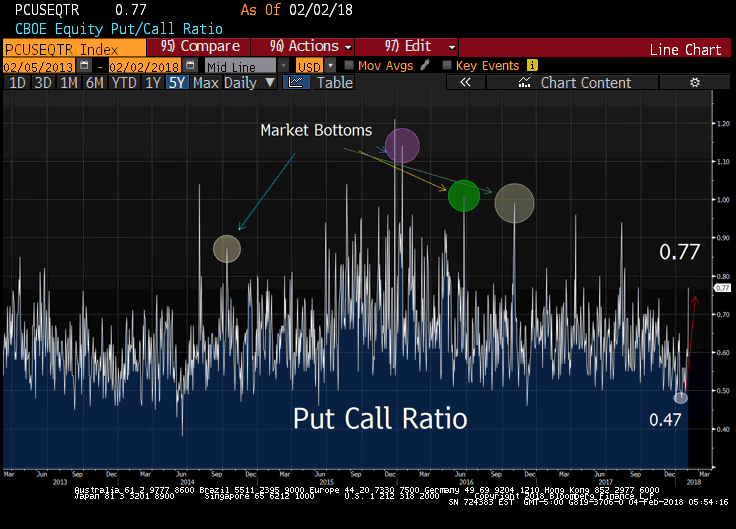
Hindsight is always 20/20, but it’s so interesting to note that three of the LOWEST readings (last five years) in the put-call ratio occurred as the U.S. equity market reached its January 2018 perch. Likewise, market bottoms are often found when put-call readings are up in the 1.00 to 1.20 neighborhood (we’re not there yet – even after Friday’s market plunge). Investors often get all “beared up” at the lows and “bulled up” at the highs, there are a lot of lessons in here. In January, mutual fund long positioning surged in tandem with the rebound in growth to a 6-year high, as some long lost investors came back to stocks. A look over at aggregate shorts in cash equities and ETFs – led by reductions in Technology shorts – (in January) is telling. This was the first time tech shorts moved below the elevated range they have been in since the financial crisis. Similar to late 1999, this outcome is a sure sign that the shorts have been carted off the field in this vicious bull market run. Right on cue, of course, January inflows into U.S. equities surged, and are on track for the largest monthly inflow on record (we’ll get the final data next week).
U.S. Treasuries and Corporate Bonds Held Overseas
Repatriation
2017: $650B
2007: $40B
*Post tax reform, as capital comes back to the United States, a very large bond buyer might NOT be there in the same way she’s been so over the last 10 years. We believe this is starting to contribute to the latest rate shock. The assumption was there was “cash” held overseas, ultimately it was actually “bonds.” Data from company SEC filings, Bloomberg and CS.
Last Time Bond Yields Surged with Equity Market Volatility?
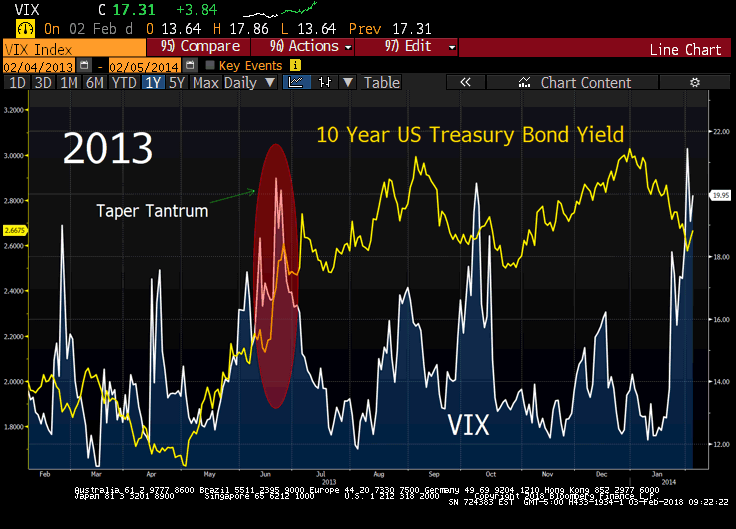
On May 22, 2013, the Federal Reserve announced that it would begin tapering back their roughly $70 billion a month in bond and mortgage-backed securities program. A series of positive economic developments in the spring of 2013 led Federal Reserve Chairman Ben Bernanke to testify to Congress on May 22, 2013, that the Fed would likely start slowing— tapering—the pace of its bond purchases later in the year, conditional on continuing good economic news. Similar to this week’s price action in markets, bond yields surged with equity market volatility as investors exited stocks and bonds together.
Pick up our latest report here:
Don’t miss our next trade idea. Get on the Bear Traps Report Today, click here
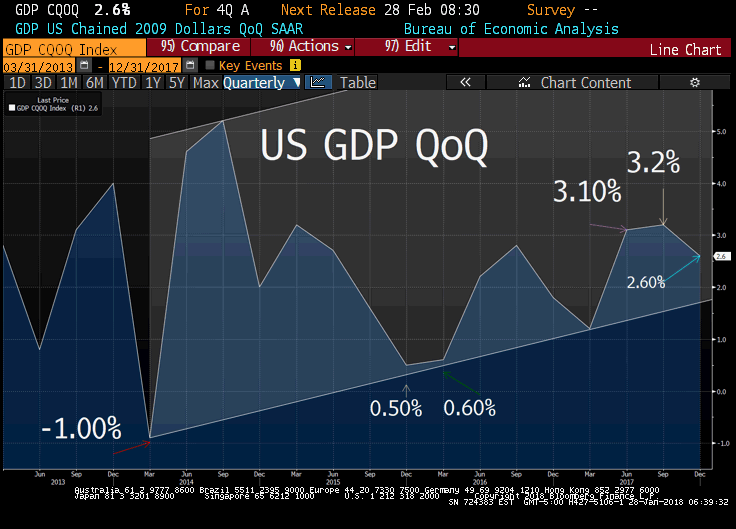 The 2.6 percent headline rate doesn’t do justice to fourth-quarter GDP where consumer spending rose a very strong 3.8 percent that reflects a 14.2 percent burst in durable spending. Bloomberg noted Residential investment, which is another consumer-related component, rose at a very impressive 11.6 percent annualized rate. Turning to business spending, nonresidential fixed investment rose at a 6.8 percent rate which is the fourth straight mid-single digit result.
The 2.6 percent headline rate doesn’t do justice to fourth-quarter GDP where consumer spending rose a very strong 3.8 percent that reflects a 14.2 percent burst in durable spending. Bloomberg noted Residential investment, which is another consumer-related component, rose at a very impressive 11.6 percent annualized rate. Turning to business spending, nonresidential fixed investment rose at a 6.8 percent rate which is the fourth straight mid-single digit result.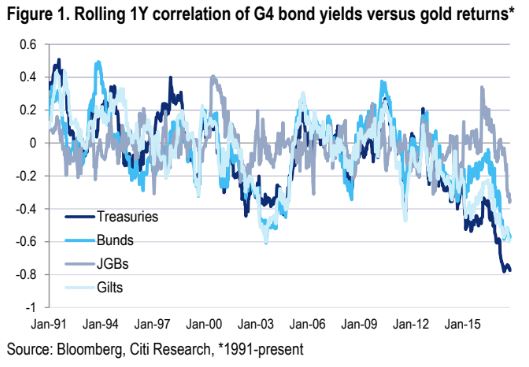
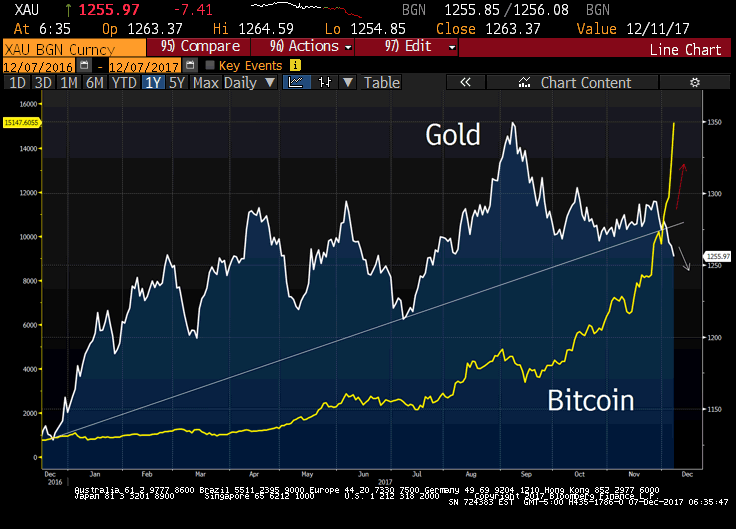 The total amount of gold above ground is 190K tonnes or $6Tr at current value. Half of that is in jewelry so left with $3Tr. Half of that is in reserves at central banks so that leaves a physical gold market size available to investors of $1.5tr (excl derivatives). Today, total cryptos are remarkably 23% of gold liquid (physical) market capitalization. The total value of all cryptocurrencies out is now $350bl of which bitcoin $250bl. So cryptos are 23% of physical gold available to investors now.
The total amount of gold above ground is 190K tonnes or $6Tr at current value. Half of that is in jewelry so left with $3Tr. Half of that is in reserves at central banks so that leaves a physical gold market size available to investors of $1.5tr (excl derivatives). Today, total cryptos are remarkably 23% of gold liquid (physical) market capitalization. The total value of all cryptocurrencies out is now $350bl of which bitcoin $250bl. So cryptos are 23% of physical gold available to investors now.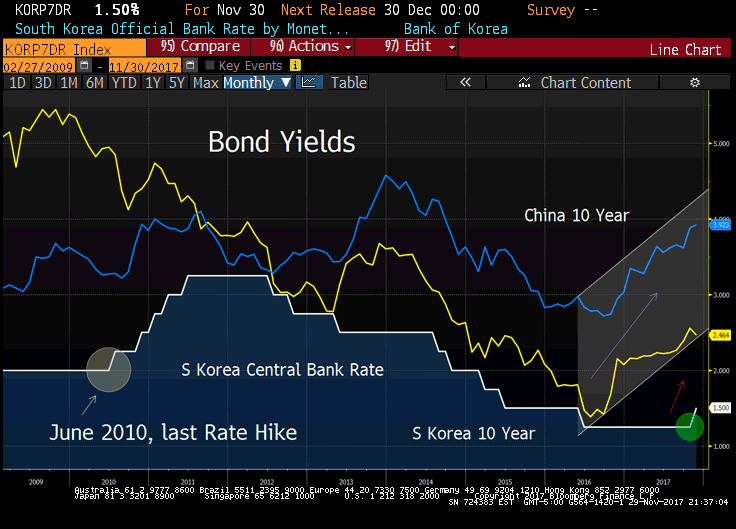 Thursday’s decision to raise the seven-day repurchase rate to 1.5 percent was forecast by 18 of 24 analysts surveyed by Bloomberg. The rest expected the central bank to leave the rate at a record-low 1.25 percent, where it has been since June 2016. As you can see above, markets widely anticipated this move – interest rates in China and S Korea have been on the rise for 15 months.
Thursday’s decision to raise the seven-day repurchase rate to 1.5 percent was forecast by 18 of 24 analysts surveyed by Bloomberg. The rest expected the central bank to leave the rate at a record-low 1.25 percent, where it has been since June 2016. As you can see above, markets widely anticipated this move – interest rates in China and S Korea have been on the rise for 15 months. 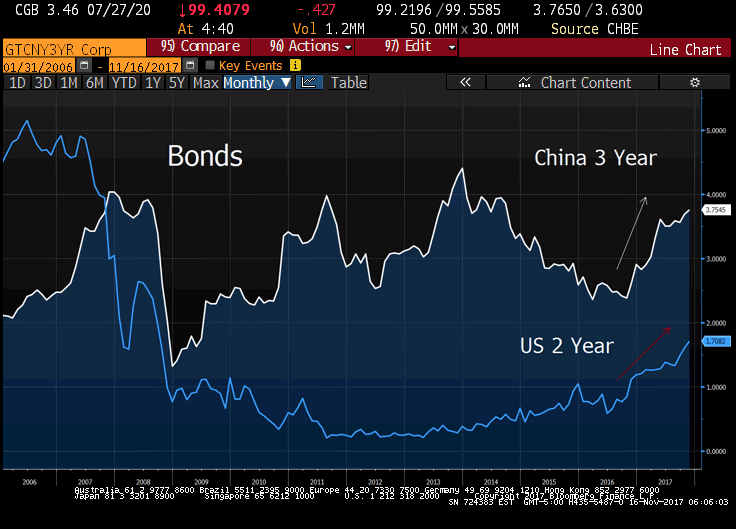 This week’s fears pushed China government bond yields to a 3-year high, taking U.S. two year Treasury bond yields north with them.
This week’s fears pushed China government bond yields to a 3-year high, taking U.S. two year Treasury bond yields north with them.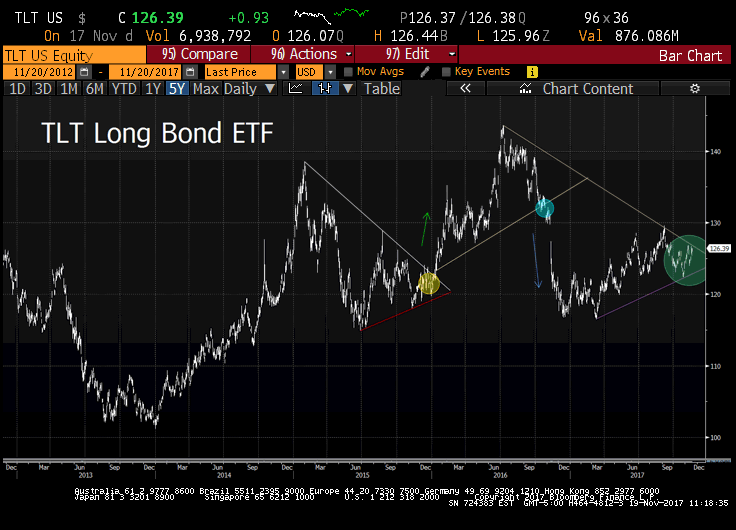 iShares 20+ Year Treasury Bond ETF seeks to track the investment results of an index composed of U.S. Treasury bonds with remaining maturities greater than twenty years. Over the last decade, wedge breaks in the technical chart pattern of the TLT have led to large moves in interest rates. Today. an important wedge is near a breach again, a true Bull – Bear battleground is forming (middle right above).
iShares 20+ Year Treasury Bond ETF seeks to track the investment results of an index composed of U.S. Treasury bonds with remaining maturities greater than twenty years. Over the last decade, wedge breaks in the technical chart pattern of the TLT have led to large moves in interest rates. Today. an important wedge is near a breach again, a true Bull – Bear battleground is forming (middle right above). 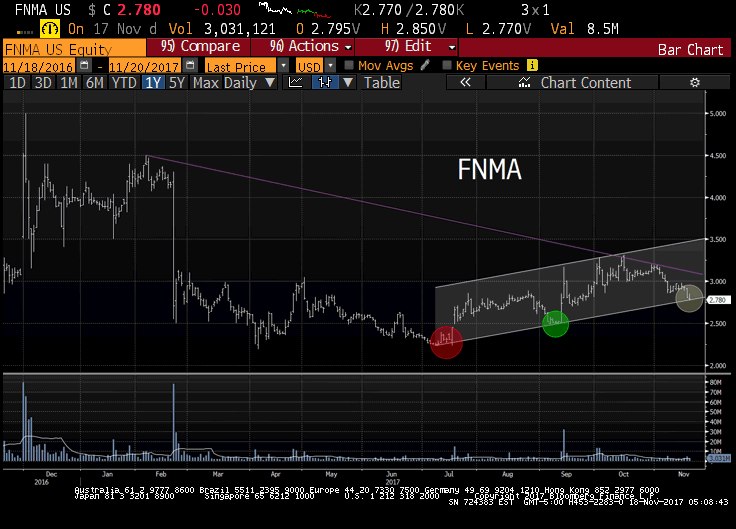 Bill Ackman’s Pershing Square Capital Management owns 44.7 million shares of FNMA, per the Bloomberg terminal. The LIFO cost basis is listed at $3.37 acquired over the last two years. This week, shares closed below their 200-day moving average. In the past five years, Fannie Mae crossed below this level 26 times and fell an average 1.7 percent in the next five days. It declined 17 times for an average loss of 3.9 percent, and advanced eight times for an average gain of 2.9 percent.
Bill Ackman’s Pershing Square Capital Management owns 44.7 million shares of FNMA, per the Bloomberg terminal. The LIFO cost basis is listed at $3.37 acquired over the last two years. This week, shares closed below their 200-day moving average. In the past five years, Fannie Mae crossed below this level 26 times and fell an average 1.7 percent in the next five days. It declined 17 times for an average loss of 3.9 percent, and advanced eight times for an average gain of 2.9 percent.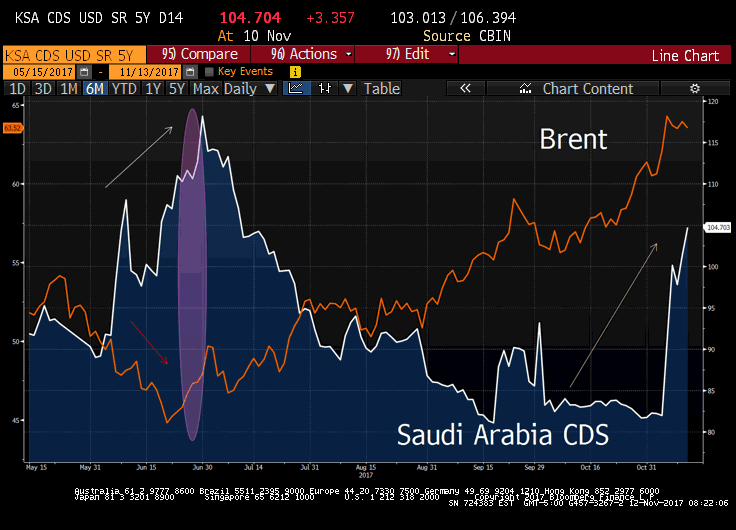 The cost of insuring Saudi Arabian debt from default is approaching two-year highs, even as oil prices globally are ripping upward. On our Bloomberg terminal, five-year CDS soared another 20 basis points last week. On the heels of a destabilizing “anti-corruption” purge in the kingdom, credit risk is on the rise. Increasing tensions with Hezbollah, an Iranian-backed militant group, have compounded investor concerns about rising political risks in the region. The last time the nation’s CDS jumped as much in a single week was in January 2016 at the height of the oil-market crash. Back then, Brent was $27, compared to $64 last week. The Kingdom’s debt profile has broadly expanded. Public debt outstanding in 2014 was down at $44B, today she’s approaching $300B, per Bloomberg data.
The cost of insuring Saudi Arabian debt from default is approaching two-year highs, even as oil prices globally are ripping upward. On our Bloomberg terminal, five-year CDS soared another 20 basis points last week. On the heels of a destabilizing “anti-corruption” purge in the kingdom, credit risk is on the rise. Increasing tensions with Hezbollah, an Iranian-backed militant group, have compounded investor concerns about rising political risks in the region. The last time the nation’s CDS jumped as much in a single week was in January 2016 at the height of the oil-market crash. Back then, Brent was $27, compared to $64 last week. The Kingdom’s debt profile has broadly expanded. Public debt outstanding in 2014 was down at $44B, today she’s approaching $300B, per Bloomberg data.
